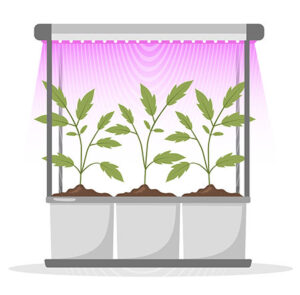Optical radiation should be chief among concerns
By Jerry Plank
 While the sheer mention of horticulture lights can bring out a snicker in those of us thinking about recreational marijuana and Cheech and Chong in the 1978 cult classic Up in Smoke, the use and design of horticultural lighting systems is an extremely important and serious topic. The use of artificial light to grow crops will increase exponentially over the next two decades as populations explode and environmental conditions deteriorate. Read on and enter into the amazing world using artificial photons to safely grow life sustaining crops.
While the sheer mention of horticulture lights can bring out a snicker in those of us thinking about recreational marijuana and Cheech and Chong in the 1978 cult classic Up in Smoke, the use and design of horticultural lighting systems is an extremely important and serious topic. The use of artificial light to grow crops will increase exponentially over the next two decades as populations explode and environmental conditions deteriorate. Read on and enter into the amazing world using artificial photons to safely grow life sustaining crops.
It’s no secret that as planet Earth becomes increasingly more populated one of the many challenges society will face is how to grow enough crops for the masses quickly, and with better yields. For a myriad of reasons such as unpredictable weather patterns, lack of irrigation water, insect infestation or available land, farming on acreage will be less and less possible or even desirable. The need to increase product yield of crops per acre of land will become a paramount goal for farmers now, and well into the future.
To better understand all the excitement surrounding horticulture lighting, a brief explanation of some of the principles is necessary. First off, an important element in crop production is the understanding of photosynthesis which is the process plants use to convert sunlight into chemical energy stored in molecules synthesized from carbon dioxide and water. A useful by-product or waste of the photosynthesis process is the release of oxygen. As far back as 1861 French scientists experimented and documented using artificial light in growing plants as artificial light sources were being invented and improved. An article written by Raymond M. Wheeler of the NASA Biological Office in December 2008 titled “A Historical Background of Plant Lighting” documents much of the early research of artificial light being used in plant growth.
EARLY REPORTS OF INCANDESCENT lamps being studied for plant growth were followed by carbon arc lamps; however, short lamp life requiring frequent replacement and the inability to emit wavelengths conducive to photosynthesis limited commercial use. As lamp development evolved, arc discharge lamps were invented and improved and showed great promise in growing plants indoors. While the design of discharge lamp sources was improved in both hours of life and wavelength, many horticultural applications still struggled with energy usage and heat generated by the lamps.
The big leap forward for horticultural lighting was the invention and subsequent improvement of LED sources—especially today where technology has improved the ability to produce wavelengths conducive to photosynthesis. The ability to tailor the spectrum of the photons emitted from LED sources and the reduction of heat and energy usage has created a new resurgence of interest in LED horticulture lights commercially.
Safety standards used by NRTLs (Nationally Recognized Testing Laboratories) evaluating lighting products typically address electrical shock and fire hazards, however, optical radiation poses a greater risk to the user of sophisticated LED sources used in horticulture lighting today as researchers try to increase photosynthetic efficiency. Accordingly, safety standards used to evaluate horticulture lighting products in Canada and the U.S. incorporate requirements from ANSI/CAN/UL 8800:2019, the safety Standard for Horticultural Lighting Equipment And Systems, for fire and electrical shock hazards; IEC 62471 (International Electrotechnical Commission), Photobiological safety of lamps and lamp systems, addressing optical radiation hazards; and IEC/TR 62471-2, Photobiological safety of lamps and lamp systems-Part 2: Guidance on manufacturing requirements relating to non-laser optical radiation.
ANSI CAN/UL 8800 is relatively straightforward, as far as safety standards go, addressing components, wiring, UV protection of polymeric materials, grounding of conductors, lamp-holders, environmental concerns based on usage for damp or wet locations, and exposure to dust and water such is the case for IP (Ingress Protection Ratings). The means for connecting the horticulture luminaire to a source of supply are also detailed for flexible cords, remote power sources, attachment plugs, mating receptacles and connectors in ANSI CAN/UL 8800.
Particular attention should be given to the ground connection on attachment plugs and mating receptacles such that the ground connection shall make first and break last to prevent electrical shocks during installation and servicing.
As part of ANSI/CAN/UL 8800 a light source shall be subjected to a photobiological assessment per IEC 62471 across the wavelength range from 280 nm through 1,400 nm—encompassing the spectral bands of 280 nm to 400 nm for ultraviolet hazard; 300 nm to 400 nm for retinal blue light hazard; 400 nm to 780 nm for retinal blue light or thermal hazard; 780 nm to 1,400 nm for cornea/lens infrared hazard; and 780 nm to 1,400 nm for retinal thermal, weak visual stimulus hazard.
The photobiological assessment required in UL 8800 is used to determine the Risk Group which further delineates the cautionary markings required on the product. The risk groups outlined in IEC 62471 are 0, 1, 2 or 3. Risk Group 0 is exempt from cautionary markings whereas Groups 1 and 2 require labeling and instructions for use outlining a warning that possible risk of injury to eyes and skin may occur during use. Risk Group 3 is not permitted to be eligible for a product Listing per UL 8800.
It should be noted that UL 8800 allows fluorescent or HID sources that are user-replaceable to avoid photobiological testing, however, the stringent marking warning of possible risk of injury to eyes and skin must be provided on the product and instructions of use.
SAFETY STANDARDS WALK A FINE LINE line between what is reasonable and what is not reasonable. Safety standards should not in any way appear to be commercial and support one technology over another nor should a safety standard preclude any emerging or new use of a technology. In the case of ANSI/CAN/UL 8800:2019, a horticultural light that is categorized as emitting Risk Group 3 is not eligible for a product safety Listing.
It is the purview of the standards-making bodies to identify risks based on proposed usage under a given set of user guidelines and a distinction should be made as to whether the equipment is for monitored, unmonitored, controlled access or uncontrolled access. Based on various factors a Risk Group 3 product in a controlled installation where the light is shielded from the user may prove to solve a unique problem with an unknown virus yet to be created.
The topic of optical radiation has been debated and studied for years and IEC 62471 does an excellent job at delineating values known to be hazardous in Table 6.1 which is titled “Emission limits for risk groups of continuous wave lamps.” In a world where everyone wants to know definitively the risks associated with a product the truth is that optical radiation hazards are a function of energy level of spectrum, duration of exposure, distance of exposure and skin pigmentation. As bacterias and viruses emerge that threaten mankind, technology for horticulture lights may prove pivotal in mitigating unknown risks in the future.


